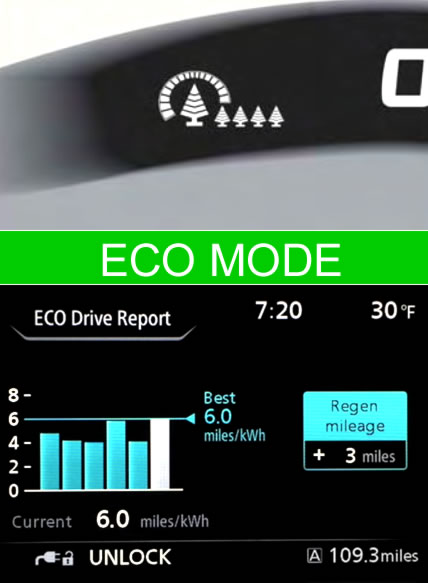How to Drive the Nissan Leaf Efficiently
Here, we’ll provide some tips on how to drive the Nissan Leaf efficiently which will help to improve the driving range. The Nissan Leaf driving range depends on several factors:
- Speed in which you drive
- Vehicle weight, passengers and load
- Electrical load from vehicle accessories
- Traffic and road conditions
- Outside temperature
You can improve the driving range of your Nissan Leaf by following basic car maintenance and by driving efficiently, otherwise known as ‘ECO driving’.
Basic Car Maintenance
Periodic and basic car maintenance helps to improve the driving range of your Nissan Leaf.
- Keep tires inflated to the correct pressure. Underinflated tires increase friction between the vehicle and the road surface which then consumes more energy to move the vehicle. You can find the recommended tire pressure label inside the driver’s door.
- Keep wheels in correct alignment. Potholes and hitting curbs can put your vehicle’s wheels out of alignment. Wheels that are not in alignment wear tires faster and require greater energy to move the vehicle.
- Remove unnecessary loads from the vehicle. The heavier the vehicle, the more energy is consumed to move it.
- If possible, pre-heat or pre-cool the interior cabin while the vehicle is charging and not while you’re on the move.
Efficient Driving
Along with basic car maintenance, efficient driving allows you to improve your driving range. To start driving more efficiently, switch on the Nissan Leaf ECO mode.

When compared to driving in normal mode (D – or Drive), ECO mode helps to reduce power consumption by reducing acceleration. ECO mode will reduce the responsiveness and acceleration capability of the Nissan Leaf, so if you need extra power for overtaking for example, you should temporarily switch ECO mode off. Additional efficient driving tips include:
- Accelerate slowly and smoothly. The harder you accelerate, the more power your Nissan Leaf will consume.
- Reduce the amount of stopping. Moving off from a stationary position uses much more power compared to when you’re already moving. You can reduce the amount of stopping by maintaining a safe following distance behind other vehicles, which often allows you to slow down gradually and avoid stopping.
- Where possible release the accelerator pedal to slow down rather than applying the brakes. This allows the regenerative brake system to charge the battery.
- Drive at moderate speeds on the highway. The faster you drive, the more power your vehicle will consume.
- Where possible, maintain consistent speeds. Constant slowing down and speeding up consumes more power. Maintain cruising speeds with constant accelerator positions or by using cruise control when appropriate.
- Turn off the air conditioner/heater when it is not necessary.
- If you do require the air conditioner or heater, select a moderate temperature setting for heating or cooling to help reduce power consumption.
- At highway speeds, use the air conditioner/heater rather than opening a window. This helps to reduce drag.
- At slower speeds, opening the windows to keep cool rather than using the air conditioner reduces power consumption.
More Information on the Nissan Leaf
![]() Nissan Leaf Dashboard Warning Lights
Nissan Leaf Dashboard Warning Lights
![]() Nissan Leaf Dashboard Icons and Meters Explained (First Generation)
Nissan Leaf Dashboard Icons and Meters Explained (First Generation)
![]() Nissan Leaf Dashboard Icons and Meters Explained (Second Generation)
Nissan Leaf Dashboard Icons and Meters Explained (Second Generation)